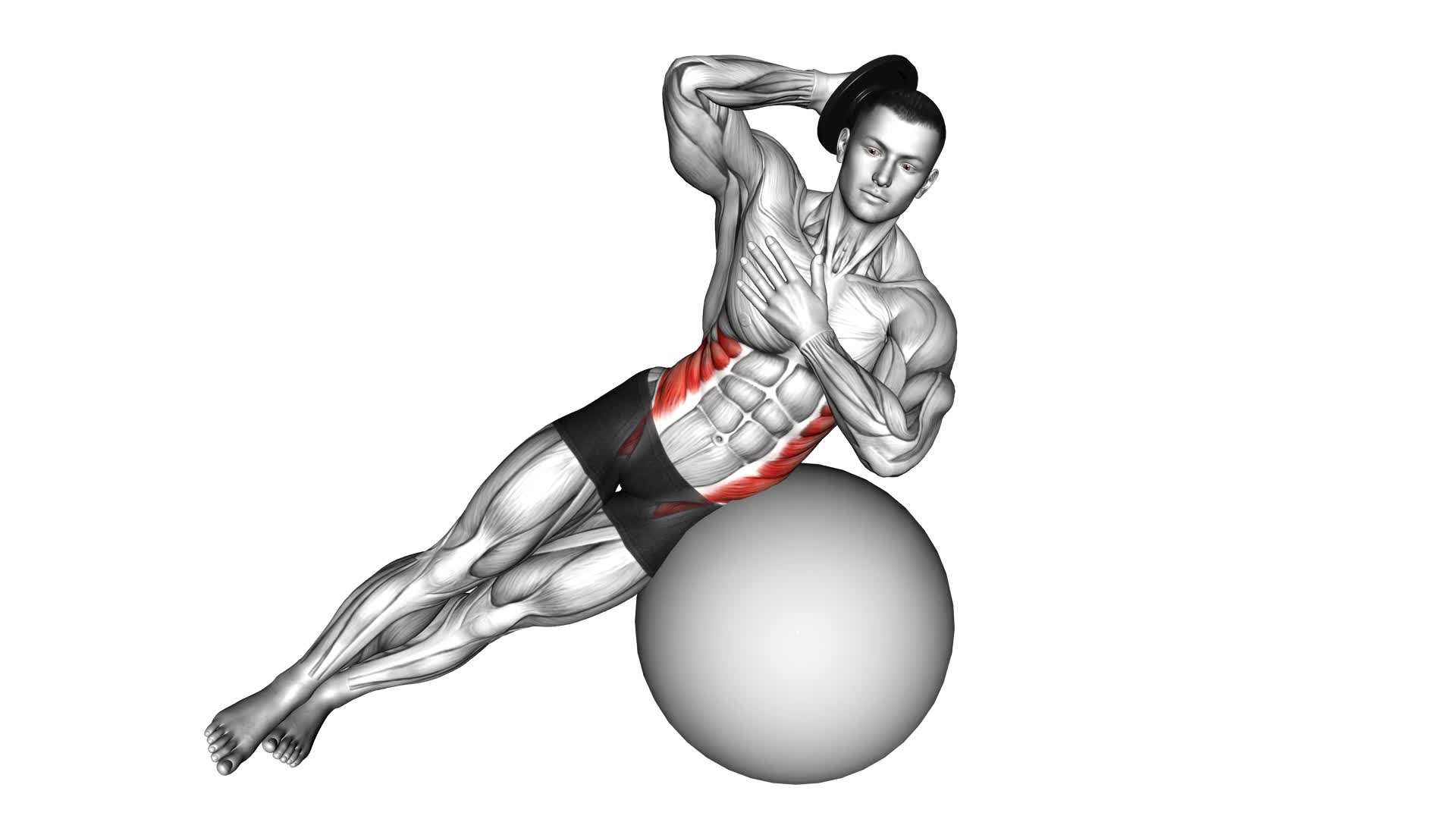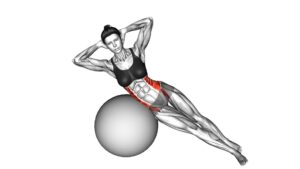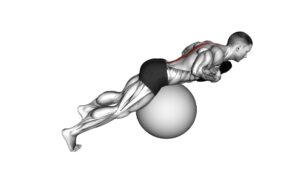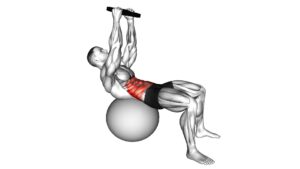Weighted Side Bend (On Stability Ball) – Video Exercise Guide & Tips

Get ready to strengthen your core and improve your stability with the weighted side bend on a stability ball.
Watch This Exercise Video
In this video exercise guide, we'll show you the proper form, equipment needed, and common mistakes to avoid. Plus, we'll provide tips for increasing the intensity and variations you can try.
Whether you're a beginner or a seasoned fitness enthusiast, this exercise will challenge your abdominal muscles and help you achieve a strong and toned midsection.
Let's get started!
Key Takeaways
- Weighted Side Bend on Stability Ball targets the oblique muscles for a more defined waistline.
- It improves overall stability, balance, and coordination.
- Engaging multiple muscle groups simultaneously, including the lower back, glutes, and hip muscles.
- Proper form and equipment are essential to maintain proper technique and avoid common mistakes.
Benefits of Weighted Side Bend on Stability Ball
The benefits of performing the weighted side bend on a stability ball are numerous. Firstly, it's a great core strengthening exercise that targets the oblique muscles, which run along the sides of your torso. By working these muscles, you can achieve a more defined waistline and improve your overall stability. Additionally, using a stability ball adds an element of instability to the exercise, forcing your core muscles to work harder to maintain balance and control. This not only enhances your core strength but also improves your overall stability and balance.
Another benefit of the weighted side bend on a stability ball is that it engages multiple muscle groups simultaneously. In addition to targeting the obliques, this exercise also works your lower back, glutes, and hip muscles. This can help to improve your posture, reduce lower back pain, and increase your overall functional strength.
Furthermore, incorporating the stability ball into your workout routine can provide additional benefits. It helps to improve your proprioception, or your body's awareness of its position in space. This can enhance your coordination and body control, making it easier to perform everyday movements and activities. Additionally, using a stability ball adds variety and challenge to your workouts, keeping them interesting and preventing boredom.
Proper Form for Weighted Side Bend on Stability Ball
To perform the weighted side bend on a stability ball, position yourself on the ball with your feet firmly planted on the ground. Start by holding a dumbbell or weighted plate with one hand and extend your arm down towards the ground. Keep your core engaged and maintain a straight posture throughout the exercise.
Proper technique is crucial to ensure you get the most out of this exercise while minimizing the risk of injury. One common mistake is using too much weight, which can strain your muscles and compromise your form. It's important to choose a weight that challenges you without sacrificing proper technique.
Another common mistake is leaning too far to the side, which can put excessive strain on your back and neck. Instead, focus on maintaining a controlled and controlled movement, keeping your core stable and your body aligned with the stability ball.
By following these proper techniques, you can effectively target your oblique muscles and improve your overall core strength.
Now that you know how to perform the weighted side bend on a stability ball with proper form, let's move on to the equipment needed for this exercise.
Equipment Needed for Weighted Side Bend on Stability Ball
To perform the weighted side bend on a stability ball, you'll need the following equipment.
- A stability ball that's the appropriate size for your height. Make sure the ball is properly inflated and sturdy enough to support your weight.
- A set of dumbbells or a weighted plate to add resistance to the exercise. Choose a weight that challenges your core muscles but still allows you to maintain proper form and control.
- A mat or towel to provide some cushioning and support for your knees or elbows, depending on how you choose to position yourself on the stability ball.
Common Mistakes to Avoid During Weighted Side Bend on Stability Ball
When performing the weighted side bend on a stability ball, it's important to avoid common mistakes that can hinder your progress and potentially lead to injury.
One common mistake to avoid is using too heavy of a weight. While it may be tempting to go for the heaviest weight you can handle, using too much weight can compromise your form and put unnecessary strain on your back and shoulders. It's important to start with a weight that challenges you, but still allows you to maintain proper form throughout the exercise.
Another common mistake isn't engaging your core. The weighted side bend is a great exercise for targeting the obliques, but if you're not actively engaging your core, you may not be getting the full benefit of the exercise. Make sure to keep your core tight and engaged throughout the movement, and focus on using your obliques to initiate the side bend.
Lastly, be mindful of your posture and alignment. It's easy to let your shoulders hunch forward or your back arch excessively during the side bend. To maintain proper form, keep your shoulders back and down, and imagine lengthening through the crown of your head. This will help to protect your spine and ensure that you're targeting the correct muscles.
By avoiding these common mistakes and maintaining proper form, you can maximize the effectiveness of the weighted side bend on a stability ball.
Now let's move on to some tips for increasing the intensity of this exercise.
Tips for Increasing Intensity of Weighted Side Bend on Stability Ball
To increase the intensity of the weighted side bend on a stability ball, you can incorporate resistance bands into your workout routine. Here are some tips for increasing the intensity:
- Use heavier weights: As you become comfortable with the exercise, gradually increase the weight of the dumbbell or resistance band to challenge your muscles even more. Start with a weight that's suitable for your strength level, and then gradually increase it as you get stronger.
- Increase the number of repetitions: Instead of doing the recommended number of repetitions, try adding a few more to your workout. This will help to fatigue your muscles and increase the intensity of the exercise.
- Slow down the movement: Instead of rushing through the exercise, focus on performing each repetition slowly and with control. This will engage your muscles for a longer period of time and make the exercise more challenging.
- Incorporate other stability exercises: To further increase the intensity of the weighted side bend, you can incorporate other stability exercises into your workout routine. For example, you can try performing the exercise on a Bosu ball or on one leg to challenge your balance and core muscles even more.
Variations of Weighted Side Bend on Stability Ball
For the variations of the weighted side bend on a stability ball, you can incorporate different hand positions to target specific muscles. These modifications can help add variety and challenge to your workout routine.
One variation is to hold a dumbbell in one hand while performing the side bend, which adds resistance and increases the intensity of the exercise. This targets the obliques and strengthens the core muscles.
Another variation is to hold a dumbbell in each hand and perform the side bend simultaneously, which engages both sides of the body and increases the overall workload. This variation is more advanced and requires good stability and control.
Additionally, you can try holding a kettlebell or a medicine ball instead of dumbbells to further challenge your balance and stability. Remember to maintain proper form and alignment throughout the exercise, and start with a lighter weight before progressing to heavier weights.
These advanced stability ball exercises will help you build strength, improve posture, and enhance overall stability.
Frequently Asked Questions
How Many Repetitions Should I Aim for When Performing the Weighted Side Bend on a Stability Ball?
When performing the weighted side bend on a stability ball, it's important to focus on the number of repetitions you aim for. By incorporating dumbbells into this exercise, you can add extra resistance and challenge your core even more.
To get the most out of this exercise, aim for a moderate number of repetitions, such as 10-12 per side. Remember to maintain proper form and engage your core throughout each repetition for optimal results.
Can I Use Dumbbells Instead of a Weighted Plate for the Exercise?
Yes, you can definitely use dumbbells instead of a weighted plate for the weighted side bend exercise. Using dumbbells as an alternative offers the same benefits of targeting and strengthening your oblique muscles.
It allows for better control and flexibility during the exercise. Just make sure to choose an appropriate weight and maintain proper form to avoid any strain or injury.
Incorporating dumbbells can add variety to your workout routine and help you achieve your fitness goals.
Is It Normal to Feel Some Discomfort in My Lower Back During the Weighted Side Bend?
Feeling some discomfort in your lower back during the weighted side bend isn't normal. It could be a sign of improper form or too much weight.
Make sure to maintain a neutral spine and engage your core throughout the exercise.
If the discomfort persists, it's best to consult with a fitness professional or healthcare provider to ensure you're performing the exercise correctly and avoid any potential injuries.
Can I Incorporate the Weighted Side Bend Into My Core Workout Routine?
Incorporating weighted side bends into your core workout routine can have several benefits. This exercise specifically targets your oblique muscles, helping to strengthen and tone them. By using a stability ball, you can also improve your balance and stability.
To perform this exercise correctly, make sure to maintain proper form and technique. Keep your back straight, engage your core, and move slowly and controlled throughout the movement. This will help prevent any discomfort or injury in your lower back.
Are There Any Modifications or Alternatives for Individuals With Limited Mobility or Back Issues?
If you have limited mobility or back issues, there are alternatives to the weighted side bend exercise. Chair exercises can be a great option, allowing you to work your core while seated.
Gentle stretching exercises can also help improve mobility and reduce back pain.
It's important to listen to your body and choose exercises that are safe and comfortable for you. Consult with a healthcare professional or a certified trainer for personalized modifications and recommendations.
Conclusion
In conclusion, the weighted side bend on a stability ball is a highly effective exercise for strengthening and toning the obliques. By using proper form and avoiding common mistakes, you can maximize the benefits of this exercise.
Additionally, incorporating variations and increasing intensity will help you continue challenging your muscles and achieving your fitness goals.
So grab a stability ball and start incorporating weighted side bends into your workout routine for a stronger, sculpted core.

Author
Years ago, the spark of my life’s passion ignited in my mind the moment I stepped into the local gym for the first time. The inaugural bead of perspiration, the initial endeavor, the very first surge of endorphins, and a sense of pride that washed over me post-workout marked the beginning of my deep-seated interest in strength sports, fitness, and sports nutrition. This very curiosity blossomed rapidly into a profound fascination, propelling me to earn a Master’s degree in Physical Education from the Academy of Physical Education in Krakow, followed by a Sports Manager diploma from the Jagiellonian University. My journey of growth led me to gain more specialized qualifications, such as being a certified personal trainer with a focus on sports dietetics, a lifeguard, and an instructor for wellness and corrective gymnastics. Theoretical knowledge paired seamlessly with practical experience, reinforcing my belief that the transformation of individuals under my guidance was also a reflection of my personal growth. This belief holds true even today. Each day, I strive to push the boundaries and explore new realms. These realms gently elevate me to greater heights. The unique combination of passion for my field and the continuous quest for growth fuels my drive to break new ground.







